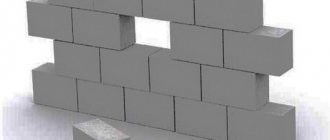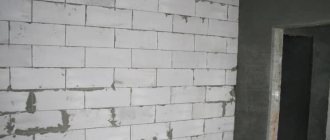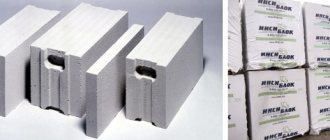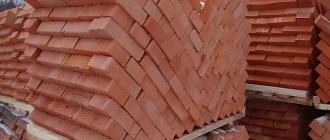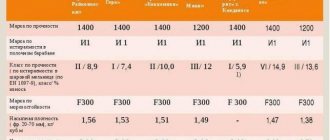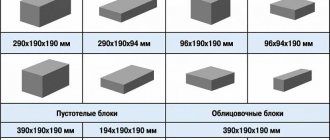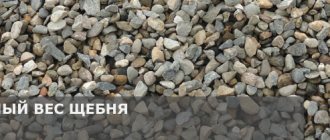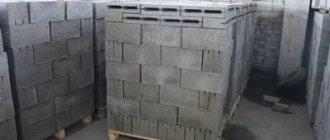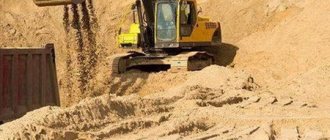How many foam blocks are in a cube or how many cubes are in a foam block pallet? These are far from idle questions for a private developer who decided to build a house from this building material with his own hands.
This cellular concrete product is widely used in low-rise, individual construction.
Photo: products on wooden pallets
How many gas blocks will fit in 1m3?
Porous concrete is available in various types and configurations. Partition products are used in construction. The amount of aerated concrete in 1 m3 depends on the parameters. In 1 cube of foam blocks measuring 600x50x250 mm, 133 pieces are placed, 600x125x250 mm - 96 pieces, 600x300x250 mm - 40. If the construction project will be carried out independently, then you need to calculate the need.
1 square requires 5 products. They are easy to process and can be easily installed when installing utility lines. Porous products are characterized by seismic resistance and strength.
When using foam concrete for construction, you need to calculate how many foam blocks are in a cube. The need is calculated by multiplying the building parameters provided for in the design documentation, minus the openings.
Calculations
How many foam blocks are required per m3? — It is necessary to divide 1 m3 by the volume of one foam block. One cube consists of 27 blocks. After simple calculations we get 27.7 pieces. In this case, rounding is downward.
Answer: 1 m3 = 27 pieces of foam blocks
Another way to obtain the number of foam blocks in a cube is to do calculations in pieces. The chosen method is performed as follows: the width, height and length of one block are multiplied among themselves, and the resulting total is divided by 1000. As a result, we get how many pieces of the selected type will be in one cube.
Calculation of foam concrete blocks
Reference: in 1 m3 there are 27 units of foam blocks measuring 200 x 300 x 600 mm. You can check by dividing 1 m3 by the volume of one standard unit. The volume is calculated by multiplying all sides of the block.
How many gas blocks with dimensions 20x30x60 in 1 cubic meter
To calculate, you need to know how many gas blocks are in 1 cube.
To determine for standard foam blocks 200x300x600 mm how many pieces are in a cube, you need to divide 1 m³ by the volume of 1 product. The number of gas blocks in a cube will be affected by their size. A number of factors are determining when calculating needs.
The volume of an aerated block is determined by multiplying its parameters. The product of standard parameters has a volume of 0.2*0.3*0.6=0.036 m³. If you divide 1 m³ by 0.036 m³, you get 27.8 pieces. Using this scheme, the number of foam blocks in a cube of a different configuration is calculated.
Why do you need to know the quantity?
Gas blocks are sold in cubic meters. Situations often arise when foam concrete blocks need to be counted not in cubes, but in pieces, since counting the quantity in pieces is more convenient when calculating construction estimates.
Knowing the dimensions of an aerated concrete block, you can determine the number of foam blocks in 1 m3 and the cost of one block. By measuring the dimensions of a stack of gas blocks installed on a pallet, you can determine the number of foam blocks in the pallet. This makes it possible to determine the amount of material in cubes required for the construction of a garage, house, service station, or office building.
How many aerated concrete blocks in 1 m3 in a pallet?
Manufacturers ship building elements in packs containing 50 pieces of aerated concrete measuring 600x300x200 mm. They occupy a volume of 1.8 m³. 25 pieces are placed on pallets measuring 0.9 m³.
If the width is 10 cm, then 64 pieces fit on a pallet. with a volume of 1.152 m³. The principle of calculating the number of gas blocks in a non-standard size pallet differs from the calculation of blocks of basic parameters. When purchasing a large batch of building material, it is not recommended to round the calculated values.
How many pieces of foam block in a pallet are determined by arithmetic. On a pallet measuring 80x120x14.4 cm, building materials are stacked in 4 rows of 8 pieces. When purchasing, losses that occur during the construction process are taken into account.
How to calculate foam blocks for a house manually?
The fastest way to calculate the number of foam concrete blocks with your own hands is to determine the square footage of all walls and the surface area of one block. However, this algorithm is applicable only in cases where the wall surface has a rectangular shape.
Condition:
- house with walls 7 and 9 m, height 3 m;
- foam block 600x300x200 mm;
- half block masonry.
Solution:
- wall length: 7 × 2 + 9 × 2 = 32 m;
- wall area: 32 × 3 = 96 m2;
- block side surface area: 0.600 × 0.200 = 0.12 m2;
- number of blocks: 96 / 0.12 m2 = 800 pcs;
- number of blocks with reserve: 800 + (800 × 0.05 (5%)) = 840 pcs.
Weight
A cube of aerated concrete with a density of 600 kg/m³ weighs 23.4 kg. Checking the weight upon receipt of the shipment allows you to compare the calculated data with the figures indicated in the accompanying documents.
A block measuring 60x30x20 cm with a density of 500 kg/m³ weighs 18 kg, 60x30x25 - 22.5 kg. A product with parameters 60x30x20 cm with a density of 700 kg/m³ - 25 kg, 60x30x25 cm - 32 kg.
If the weight of the pallet differs from the value established by the standards, this indicates low quality of the blocks and a violation of the production technology.
Density
This indicator is proportional to the grade of concrete. Each type of building element is used to lay structures with different loads. In order not to make a mistake when choosing a brand, you should familiarize yourself with their purpose. Aerated concrete D600 is characterized by high strength.
Monoliths are erected from D500 blocks, D 400 - for arranging insulation when installing openings. Products made from aerated concrete D350, which has high porosity and a loose structure, are used primarily for heat insulation.
The material absorbs moisture, so a moisture-insulating soil ball is applied to the walls. The block manufacturing technology involves mixing the ingredients, which, when interacting, form a porous structure. High-density building elements have more weight.
How much aerated concrete in a cube can be determined by the density of the block. This indicator is designated D, and the numbers after the letter marking indicate the density value. A low index value corresponds to the presence of a large number of air pores, which increase heat conductivity.
The strength index of the D400 gas block is 45% higher than that of D300, but the thermal conductivity is 30% lower. The price of building products of the D400, 200, 300, 600 cm brand in Moscow and other regions is lower than for similar products of higher density.
Advantages
The porosity structure of foam concrete is closed - the bubbles in it are isolated from each other. Thanks to this, the foam concrete block does not sink in water. Whereas, a block of aerated concrete having the same specific density disappears under water within a couple of hours. Also, the advantages of foam concrete include good heat-shielding characteristics and frost resistance. Thanks to these properties, foam concrete is not afraid of high humidity.
Thanks to all this, this particular material began to be used to insulate floors, roofs, foundations and walls.
Foam concrete is an environmentally friendly material. Its performance in this regard is much higher than that of aerated concrete.
Options
Structural parts with densities D900 and D1200 are characterized by high strength and weight. Thermal insulation elements D500-900 are used in the construction of 3-story buildings with walls laid in 1 layer.
Thermal insulation products of the D400 and D500 brands are used when arranging partitions inside structures. Aerated concrete blocks differ in configuration. The walls are laid from standard type products, and reinforced beams made of foam concrete are used to construct the ceilings.
Such products are durable, reliable in operation, and designed for maximum permissible loads. Installation of floors is carried out from T-shaped structures with parameters 600x250x200 mm.
Technological and design developments of manufacturers are aimed at facilitating construction. An excellent solution are special blocks with an arcuate configuration. Formwork is made from hh type products along the outer contour.
There are two types of gas blocks
Porosity, which depends on production technology and additives, determines the properties of building elements. Foam concrete is produced using autoclave and non-autoclave methods.
The working mixture consists of the following components:
- lime;
- cement;
- aluminum powder;
- quartz sand
- gypsum;
Mixing the ingredients and filling the molds is carried out using standard technology. The difference between the materials lies in the drying method. Autoclaved concrete matures in special chambers, while the other type matures in natural conditions.
As a result of autoclave processing, the building material acquires strength and resistance to low temperatures. This production technology provides automatic control, which allows you to set the necessary parameters in advance.
Materials made using various technological processes are slightly different, but are characterized by a number of advantages:
- low price;
- excellent insulating properties;
- easy to cut and saw into pieces and according to a given configuration;
- fire and environmental safety;
- biological stability;
- maintaining original properties for 100 cycles;
- lack of ability to rot.
Insulation parameters depend on the brand of concrete used. When choosing, it is recommended to take into account the requirements of technical and construction standards. For walls with a thickness of 350-450 mm, aerated concrete grade D400-500 is chosen.
For the construction of external and load-bearing walls, autoclaved building elements of grades D500-600 are used, which are characterized by increased density. The material is used for the construction of objects in any climatic conditions. For laying internal walls, D400 brand products are used, which retain heat.
Aerated concrete blocks can withstand the load of floor slabs. The material does not require additional treatment with antiseptic compounds; according to SNiP standards, the noise insulation index is in the range of 41-60 dB.
Standard product sizes
The dimensions of the elements are determined based on technical parameters and requirements for building materials. This takes into account the features of installation and the composition used for the connection.
Material characteristics may vary depending on purpose, configuration and load. Building codes provide requirements that manufacturers must adhere to.
Rectangular gas blocks have the following parameters, see:
- height - 20, 25:
- length - 60, 62.5;
- width - 10-40.
Often this figure is 30 cm, but can vary depending on a number of factors. The selection of material is carried out taking into account the loads on wall structures.
U-shaped products are produced with the following parameters
This type of building elements is used to construct monolithic stiffeners. The internal space is filled with concrete and reinforcement. Blocks of a U-shaped configuration have a height of 25 cm, length - 50-60 cm, width - 20-40 cm. Building elements are used in laying openings and securing floor slabs.
Introduction
It has an optimal combination of consumer, operational characteristics and properties that attract the developer, for example:
- thermal insulation,
- soundproofing,
- environmental friendliness,
- relative speed of building a house,
- price,
- fire safety,
- light weight.
Comparative characteristics of some popular products actively used in construction
Along with arithmetic and geometric calculations, before designing and constructing a building, it is necessary to learn more about the material itself, the norms and rules for working with it, set out in regulatory documents.
Documentation
Construction standards and guidelines for the manufacture of aerated concrete products, which include the material in question for masonry walls:
- GOST 25485 - 89 “Cellular concrete. Technical conditions".
- GOST 12852.0 - 77 “Cellular concrete. General requirements for test methods."
- GOST 5742 - 76 “Heat-insulating products made of cellular concrete.”
- SN 277 - 80 "Instructions for the manufacture of products from cellular concrete."
